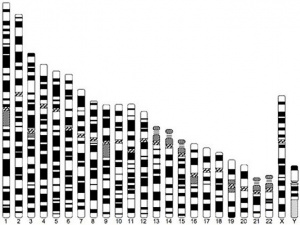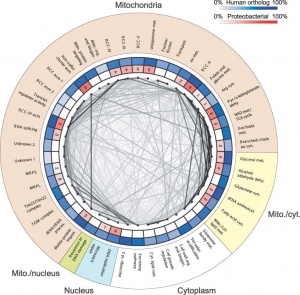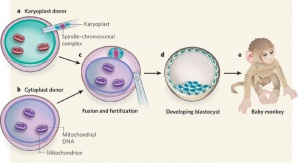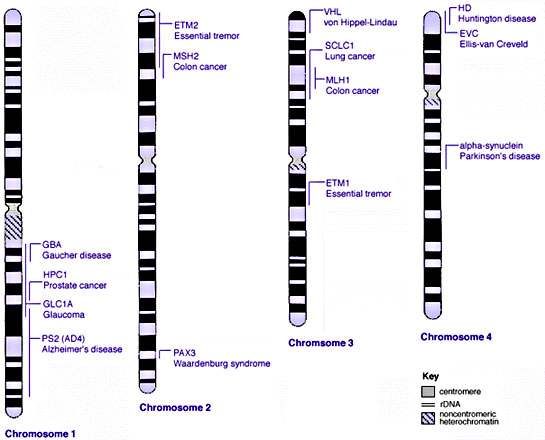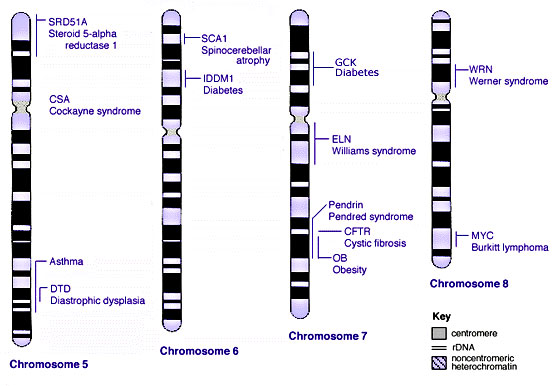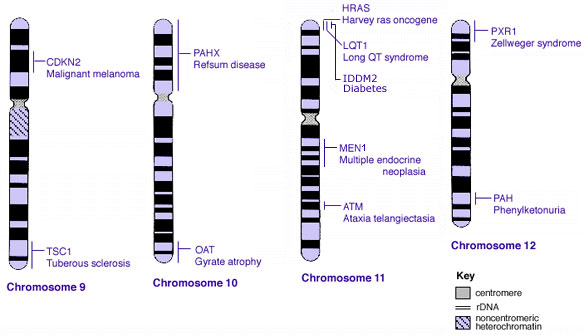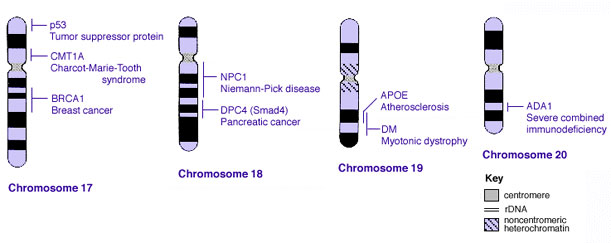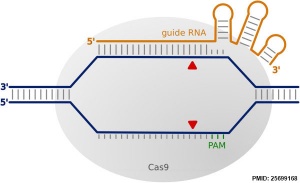Molecular Development - Genetics: Difference between revisions
mNo edit summary |
mNo edit summary |
||
| Line 3: | Line 3: | ||
[[File:Human idiogram.jpg|thumb|Human idiogram]] | [[File:Human idiogram.jpg|thumb|Human idiogram]] | ||
Genetics (Greek, ''genetikos'' = “origin”) and embryology have merged to such an extent that the two cannot now be separated from each other. The strong evolutionary conservation of developmental mechanisms has been astounding. Currently, much of modern medicine is a search for a disease gene and having found it, embryology is usually employed in understanding its mechanism. Embryological development begins with [[Cell Division - Meiosis|meiosis]] and is after all the opportunity for a specific genome to be expressed, regulated and utilized as it will never be again in the adult animal. | Genetics (Greek, ''genetikos'' = “origin”) and embryology have merged to such an extent that the two cannot now be separated from each other. The strong evolutionary conservation of developmental mechanisms has been astounding. Currently, much of modern medicine is a search for a disease gene and having found it, embryology is usually employed in understanding its mechanism. Embryological development begins with [[Cell Division - Meiosis|meiosis]] and is after all the opportunity for a specific genome to be expressed, regulated and utilized as it will never be again in the adult animal. | ||
In combination with our statistical understanding of congenital abnormalities there now exist a large number of clinical tests for inherited abnormalities. This particular section of the notes is a link to bind our understanding of genetics with its relevance to development. There are several pages on DNA and links from the computer activities below to relevant sections. You can jump right in and look through the DNA database for a gene of interest using a keyword, or browse through the human genome by chromosome or by genetic diseases that have been identified. Or you can work through an exercise in using genetic databases for diseases. | In combination with our statistical understanding of congenital abnormalities there now exist a large number of clinical tests for inherited abnormalities. This particular section of the notes is a link to bind our understanding of genetics with its relevance to development. There are several pages on DNA and links from the computer activities below to relevant sections. You can jump right in and look through the DNA database for a gene of interest using a keyword, or browse through the human genome by chromosome or by genetic diseases that have been identified. Or you can work through an exercise in using genetic databases for diseases. | ||
See also the list of [[Talk:Molecular Development - Genetics#Mouse Gene Knockouts Listed according to the Name of the Gene|mouse gene knockouts]] which has made the geneticists not only use embryological tools, but also go back and learn some embryology. Recent research has also focussed on the new science of [[Molecular Development - Epigenetics|Epigenetics]], the inheritance mechanisms that lie outside the actual DNA sequence of our genes. | See also the list of [[Talk:Molecular Development - Genetics#Mouse Gene Knockouts Listed according to the Name of the Gene|mouse gene knockouts]] which has made the geneticists not only use embryological tools, but also go back and learn some embryology. Recent research has also focussed on the new science of [[Molecular Development - Epigenetics|Epigenetics]], the inheritance mechanisms that lie outside the actual DNA sequence of our genes. | ||
Revision as of 14:46, 29 September 2015
| Embryology - 18 Apr 2024 |
|---|
| Google Translate - select your language from the list shown below (this will open a new external page) |
|
العربية | català | 中文 | 中國傳統的 | français | Deutsche | עִברִית | हिंदी | bahasa Indonesia | italiano | 日本語 | 한국어 | မြန်မာ | Pilipino | Polskie | português | ਪੰਜਾਬੀ ਦੇ | Română | русский | Español | Swahili | Svensk | ไทย | Türkçe | اردو | ייִדיש | Tiếng Việt These external translations are automated and may not be accurate. (More? About Translations) |
Introduction
Genetics (Greek, genetikos = “origin”) and embryology have merged to such an extent that the two cannot now be separated from each other. The strong evolutionary conservation of developmental mechanisms has been astounding. Currently, much of modern medicine is a search for a disease gene and having found it, embryology is usually employed in understanding its mechanism. Embryological development begins with meiosis and is after all the opportunity for a specific genome to be expressed, regulated and utilized as it will never be again in the adult animal.
In combination with our statistical understanding of congenital abnormalities there now exist a large number of clinical tests for inherited abnormalities. This particular section of the notes is a link to bind our understanding of genetics with its relevance to development. There are several pages on DNA and links from the computer activities below to relevant sections. You can jump right in and look through the DNA database for a gene of interest using a keyword, or browse through the human genome by chromosome or by genetic diseases that have been identified. Or you can work through an exercise in using genetic databases for diseases.
See also the list of mouse gene knockouts which has made the geneticists not only use embryological tools, but also go back and learn some embryology. Recent research has also focussed on the new science of Epigenetics, the inheritance mechanisms that lie outside the actual DNA sequence of our genes.
Some Recent Findings
Diploid Chromosome Number
| Species | Chromosome Number |
|---|---|
| Human (Homo sapiens) | 46 |
| Mouse (Mus musculus) | 40 |
| Fruit fly (Drosophila melanogaster) | 8 |
| Worm (Caenorhabditis elegans) | 12 |
| Frog (Xenopus laevis) | 36 |
| Dog (Canis familiaris) | 78 |
| Chicken (Gallus gallus) | 78 |
| Echidna (Tachyglossus) | 63 male 64 female |
| Cow (Bos primigenius) | 60 |
Chromatin Structure
| Cells not undergoing cell division have their DNA dispersed throughout the nucleus in what are know as "chromosomal domains". There is also a peripheral nuclear rim area that does not contain gene-rich regions of DNA, which tend to be located in the core of the nucleus. | 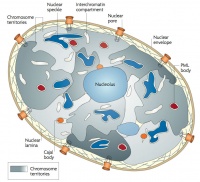 
Adult G0 fibroblast DNA and gene localization.[2] |
| Cells undergoing division have their DNA compacted into chromosomes with a long arm (q) a short arm (p) and a mid-section (centromere). The duplicated chromosomes are also joined together as pairs at the centromere. | 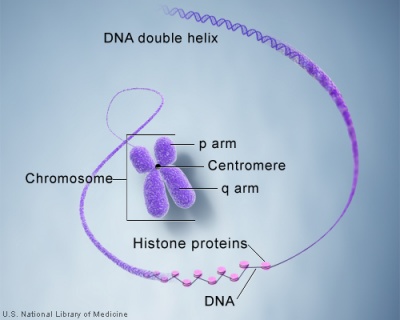
Chromosome pair structure |

Chromosome Banding
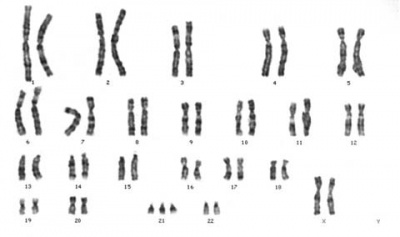
The term refers to the light and dark pattern, seen after staining with a dye, of individual chromosomes identified in metaphase. It is only in meiosis and mitosis during metaphase that chromosomes can be easily identified, during the normal cell life (interphase) the chromosomes are unravelled and distributed within the nucleus in chromosome territories. A band is that part of a chromosome which is clearly distinguishable from nearby regions by appearing darker or brighter with one or more banding techniques.
Depending on the type of stain used a number of different banding patterns can be seen:
- G-banding - banding pattern seen by treating with trypsin and then staining with the dye giemsa.
- R-banding - banding pattern seen as a of reverse giemsa chromosome banding, producing bands complementary to G-bands often used to determine whether there are deletions. Can be fluorescent using the dye acridine orange.
- Q-banding - banding pattern seen by treating with a fluorochrome or the fluorescent dye quinacrin.
- C-banding - banding pattern seen for centromeric or constitutive heterochromatin, the centromere appears as a stained band compared to other regions.
Metaphase is a cell division term referring to the third mitotic stage, mitotic spindle kinetochore microtubules align chromosomes in one midpoint plane. Metaphase ends when sister kinetochores separate. Originally based on light microscopy of living cells and electron microscopy of fixed and stained cells. A light microscope analysis called a "metaphase spread" was originally used to detect chromosomal abnormalities in cells.
- Links: Histology Stains
Human Genome
Human Genome Length 3,101,788,170 bp. Mitochondrial Genome 16,568 bp.
- Links: Human Genome Project (HGP) | NCBI Human Genome Resources | History of the Human Genome Project | Project Timeline
Nuclear Genome
Mitochondrial Genome
- In humans this genome is maternally inherited.
- Exists as multiple copies within the matrix of each mitochondrion within the cytoplasm of cells.
- In 1981 the human mitochondrial genome was sequenced.
- The genome is a small circular DNA molecule 16,568 bp in length containing 37 genes.
- 24 genes specify RNA molecules involved in protein synthesis (22 transfer RNAs (tRNA) and 2 ribosomal RNAs (rRNA))
- 13 genes encode proteins required for the biochemical reactions that make up respiration.
Swapping mitochondrial DNA mammalian oocytes[3] Assisted Reproductive Technology
Chromosome Regions
Chromosome Abnormalities
Ploidy refers to the chromosomal genetic content of cells. Euploidy (euploid) is the genetic term used to describe the normal cell genome chromosomal set (n, 2n, 3n) or complement for a species, in humans this is diploid (2n).
The terms used to describe the classes of numerical chromosomal abnormalities include:
- Aneuploidy are chromosome mutations in which chromosome number is abnormal (increased or reduced), nondisjunction in meiosis or mitosis (anaphase of meiosis I, sister chromatids fail to disjoin at either meiosis II or at mitosis) is the cause of most aneuploids.
- Polyploidy includes triploidy, usually due to two sperm fertilizing a single egg.
- Mixoploidy includes mosaicism, where there are two or more genetically different cell lines in an individual.
- Links: Abnormal Development - Genetic | Trisomy 21 | Trisomy 18 | Trisomy 13)
Some Human Disease Gene Locations
Inheritance Genetics
- Inheritance Pattern images: Genetic Abnormalities | autosomal dominant | autosomal recessive | X-linked dominant (affected father) | X-Linked dominant (affected mother) | X-Linked recessive (affected father) | X-Linked recessive (carrier mother) | mitochondrial inheritance | Codominant inheritance | Genogram symbols | Genetics
Genogram
A clinical diagram constructed to show an individual's family relationships and medical history, more detailed than a pedigree chart including non-genetic factors such as family emotional and social relationships. Additional colour coded symbols and connectors are used to show these relationships and interactions.
DNA Sequencing
Changes in genes can occur by a number of different methods including mutations, deletions and epigenetic modifications. Specific changes in DNA sequences can also be detected by a range of techniques, including direct sequencing of the DNA.
Recent technological developments have improved how DNA sequencing occurs and we are said to now be up to the "third generation" of sequencing techniques.[4]
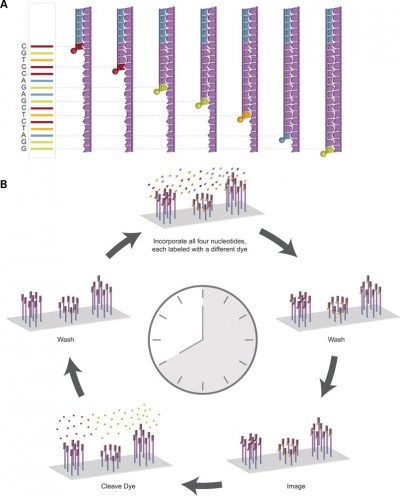
|
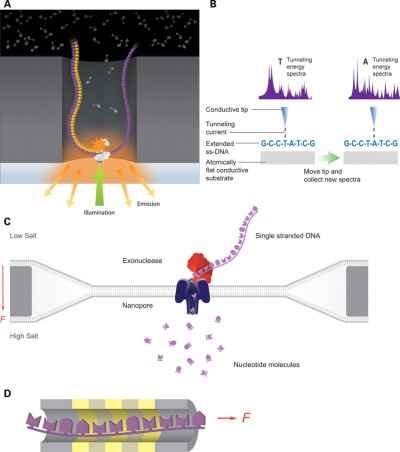
|
| First and second generation sequencing[4] | Third generation sequencing[4] |
Using Genetic Databases
This exercise is an exploration of the available WWW and other database resources that relate to Human genetic diseases. The exercise is to explore the Human genome and its relationship to examples of know human genetic diseases that affect development and impact on health.
To start with, think of a specific Human disease and see what you can find out about:
- Known gene?
- What are the major effects of the disorder?
- Does it have an effect/role in development?
- Known mutations?
- Likely hood of mortality?
- History of the disease?
- Who discovered the cause of the disease?
- Most recent published data relationg to the disease?
- What therapies are being explored?
- Where to next?
Genetic Editing
Originally a more general approach was used to study the fly model of development, where random genome mutation (random mutagenesis) was carried out to identify a specific fly phenotype and then researchers would go back and find the gene that had been altered.
More recently in vertebrate models of development, mainly in mice, genetic editing was carried to to "knock out" (KO mice) a specific gene and then to look for a specific phenotype. Generally targeting known genetic disorder genes, but later a range of genes involved in signalling, proliferation, migration, cell cytoskeleton. This technology has developed to the stage where we can now not only "knock out" but also "knock in" as well as "transiently knock out" (at a specific stage) a specific gene of interest. This KO technology was complex and required long term projects to generate these knock out animal models.
More recently a new technology called CRISPR-Cas9 (clustered regularly interspaced short palindromic repeats/CRISPR-associated nuclease 9) has allowed more accurate and faster genetic editing. There has been concern in the scientific community that this technique may be applied to the human genome, and lead to "germ line" changes in the human genome.
- Links: Nature News 12 March 2015
References
- ↑ <pubmed></pubmed>
- ↑ <pubmed>15839726</pubmed>| PLoS Biol.
- ↑ <pubmed>19759608</pubmed>
- ↑ 4.0 4.1 4.2 <pubmed>20858600</pubmed>| Hum Mol Genet.
Online Textbooks
- Genomes (2nd edition) Brown, T.A. New York and London: Garland Science ; c2002 PMID20821850
- Introduction to Genetic Analysis Griffiths, Anthony J.F.; Miller, Jeffrey H.; Suzuki, David T.; Lewontin, Richard C.; Gelbart, William M. New York: W. H. Freeman & Co.; c1999
- Modern Genetic Analysis Griffiths, Anthony J.F.; Gelbart, William M.; Miller, Jeffrey H.; Lewontin, Richard C. New York: W. H. Freeman & Co.; c1999
- Human Molecular Genetics 2 Strachan, Tom and Read, Andrew P. New York and London: Garland Science; c1999
- Genetics for Surgeons Morrison, Patrick J.; Spence, Roy A.J., authors Hatchwell, Eli, series editor London: Remedica; c2000
- Sequence - Evolution - Function: Computational Approaches in Comparative Genomics Koonin, Eugene V; Galperin, Michael Y. Norwell (MA): Kluwer Academic Publishers ; c2003
- The Genetic Landscape of Diabetes [Internet] Dean, Laura; McEntyre, J.R. Bethesda (MD): National Library of Medicine (US), NCBI; 2004 Jun
- Madame Curie Bioscience Database Chapters taken from the Madame Curie Bioscience Database (formerly, Eurekah Bioscience Database) Eurekah.com and Landes Bioscience and Springer Science+Business Media; c2009
Reviews
<pubmed>16314867</pubmed>
Articles
Search PubMed
Not easy to generate a good search term for this topic.
Search "Genetic Development" All (151839) Review (31389) Free Full Text (54818)
Search Pubmed: Genetic Development | Genome
Genetic Terms
External Links
External Links Notice - The dynamic nature of the internet may mean that some of these listed links may no longer function. If the link no longer works search the web with the link text or name. Links to any external commercial sites are provided for information purposes only and should never be considered an endorsement. UNSW Embryology is provided as an educational resource with no clinical information or commercial affiliation.
- Human Genome Project (HGP) | History of the Human Genome Project | Project Timeline
- NCBI Human Genome Resources
- Online Mendelian Inheritance in Man
- NHGRI Catalog of Published Genome-Wide Association Studies | PDF
- Genome-Wide Associations (GWA) Karyogram
- Idiogram Album David Adler
- Genetic Education Resources for Teachers
- MITOMAP A human mitochondrial genome database.
- Galaxy is an open, web-based platform for data intensive biomedical research. Whether on this free public server or your own instance, you can perform, reproduce, and share complete analyses.
Glossary Links
- Glossary: A | B | C | D | E | F | G | H | I | J | K | L | M | N | O | P | Q | R | S | T | U | V | W | X | Y | Z | Numbers | Symbols | Term Link
Cite this page: Hill, M.A. (2024, April 18) Embryology Molecular Development - Genetics. Retrieved from https://embryology.med.unsw.edu.au/embryology/index.php/Molecular_Development_-_Genetics
- © Dr Mark Hill 2024, UNSW Embryology ISBN: 978 0 7334 2609 4 - UNSW CRICOS Provider Code No. 00098G
